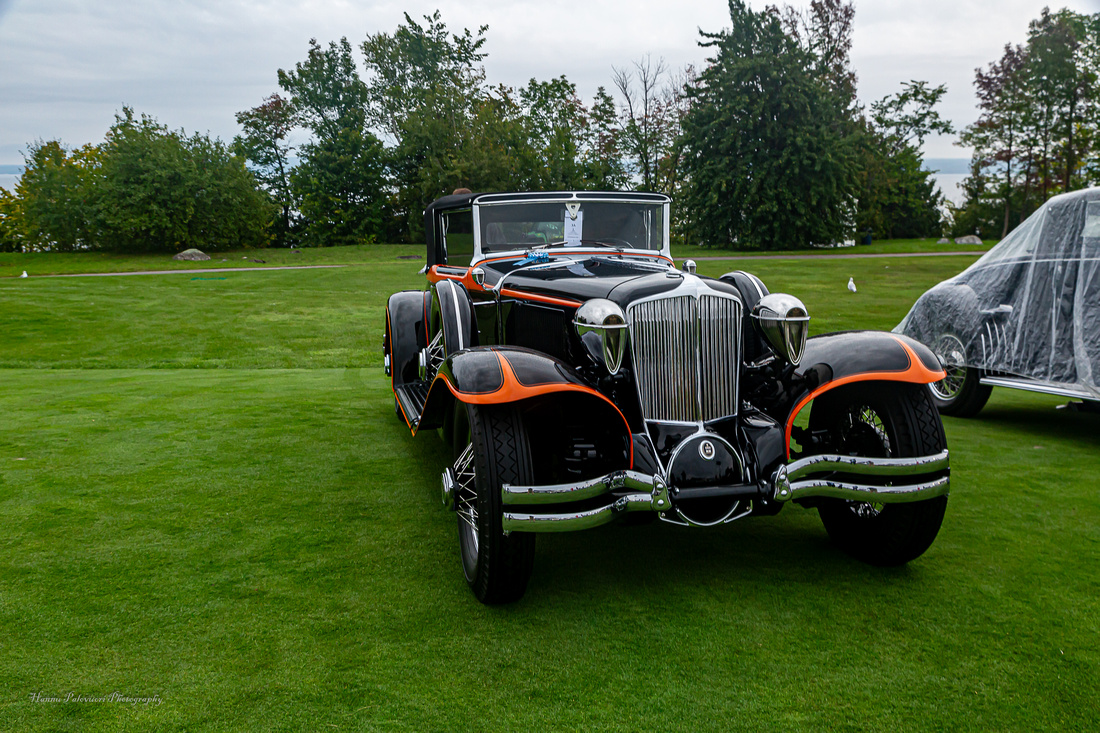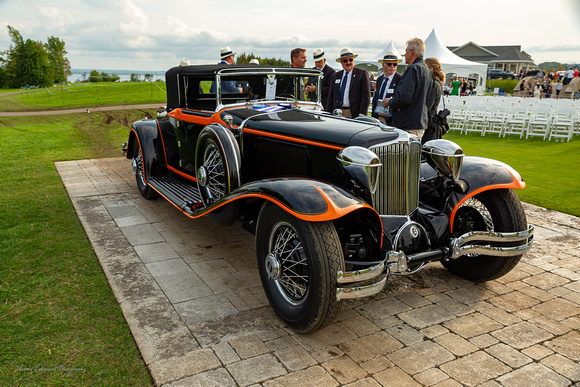1929 Cord L-29


The 2024 Cobble Beach Concours d'Elegance is fast approaching, so it seems to be a great time to look at the Best Of Show 2023.


1929 Cord L-29, owned by Greg Ornazian of Rochester Hills, Michigan, USA. It is the 56th Cabriolet built in Auburn, Indiana, fitted with famed "Woodlite" headlamps and taillights and with "hard-covered" side - mount spare covers.
The fast rise and eventual collapse of E.L. Cord’s massive industrial empire, with the Auburn, Cord and Duesenberg marques at its core, remains one of corporate America’s most fascinating and tragic stories. From his dramatic turnaround of Auburn in the mid-1920s, made possible by a textbook case of effective marketing, Cord’s companies manufactured and sold some of the most innovative, stylish and value-rich automobiles ever conceived
By 1927, Cord perceived a niche for a new medium-priced car with innovative engineering and distinctive styling The L-29 Cord was built as a gap-filling model priced between his Cord Corporation's Auburn and Duesenberg lines
The first model offered by Cord was the L-29. Introduced in 1929, the L-29 was not only the first Cord, but it became the first successful volume-built front-drive car in the USA, beating the Ruxton automobile by several months, in 1929.
Its drive system borrowed from the Indianapolis 500-dominating racers, using the same de Dion layout and inboard brakes. The L-29 used a pair of quarter-elliptic leaf springs on each side to provide both location and suspension. While the paired springs offered some mutual self-damping, there was a hefty Houdaille hydraulic shock absorber on each wheel


L-29 Cord combined its engine, transaxle, and clutch into one co-located assembly, eliminating a conventional driveshaft. This permitted a 10-inch lower chassis and necessitated a lengthy hood that appeared even longer because the designer, Al Leamy, surrounded the radiator with an integrated sheet-metal assembly, finished to match the car’s color.


The low-slung Cord’s bodylines were exquisite. Features include an Art Deco styled transaxle cover, an elegant, streamlined grille that evoked the styling of Harry Miller’s racing cars, sweeping clamshell fenders, sleek body side reveals which accentuated the car’s length, and a low roofline. These are embellished by myriad Art Deco styled details ranging from accented fender trim, tapered headlamp shapes, etched door-handle detailing and tiny, but exquisite instrument panel dials. Including a temp. gauge, oil pressure gauge, and speedometer on the left with a gas gauge, oil level gauge, and Ammeter on the right of the steering wheel.


The engine was Lycoming, a straight-eight 'flat head' unit displacing 298 cubic inches and fitted with a single carburetor, helping to develop 125 horsepower at 4,000 RPM. 4,700 lb (2,100 kg). The car was underpowered, limited to a trifle over 80 mph (130 km/h), inadequate even at the time. The engine was modified with a front-mounted flywheel that made access to the timing chain problematic. The transmission was a three – speed manual selected from Detroit Gear, which design was no longer in production, prompting a restart of the assembly line.
The steering required four turns lock-to-lock. The wheelbase measured 137.5 inches, and the height of the sedan was 61 inches.
Cord's drivetrain would be fitted in Herb Snow's (and Van Ranst) new X frame chassis - the world's first. Because nobody in America had more experience with front-wheel drive than race car builder Harry Miller, Cord purchased the rights to adapt Miller's race car design to passenger cars. What worked at the Indianapolis Motor Speedway proved suboptimal on suburban streets. Cord reached out to Cornelius W. VanRanst, whose "Detroit Special" racer proved far easier to drive, VanRanst was promoted to chief engineer for Cord, even though he believed the L-29 was little more than an assemblage of outdated parts and nearly incompatible systems.


The Cord L-29 was offered in various factory bodies, including custom coachwork created by American and European coachbuilders.


43 custom-bodied L-29s were created and currently twelve are known to remain in existence today. Initially, L-29 coachwork included a sedan, brougham convertible coupe, and Phaeton with prices that ranged from $3,095 to $3,295. Just 5,010 L-29s were ever built, of which approximately 300 remain in existence
The L-29 Cord’s art moderne styling and engineering prowess attracted buyers of taste and style who were not afraid to try something different. Owners included the era’s most prominent and controversial architect, Frank Lloyd Wright.


Sorces:
https://www.supercars.net/blog/1929-cord-l-29/
https://www.classic.com/m/cord/l-29/
https://www.macsmotorcitygarage.com/inside-the-1929-32-cord-l-29-front-drive/
https://acdamstore.com/products/1929-cord-l-29-broughman
https://www.conceptcarz.com/vehicle/z11205/cord-l-29.aspx
https://www.sportscarmarket.com/profile/1929-cord-l-29-special-coupe
https://fristartmuseum.org/1930-cord-l-29-cabriolet/
https://www.rmw.lv/car/lv/l29-convertible-coupe
https://www.hemmings.com/stories/2013/09/19/cars-of-futures-past-cord-l-29